Great Migrations of the Serbs
Part of a series on the |
||||||||||||||||
|---|---|---|---|---|---|---|---|---|---|---|---|---|---|---|---|---|
| History of Serbia | ||||||||||||||||
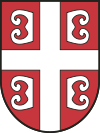 | ||||||||||||||||
|
||||||||||||||||
|
||||||||||||||||
|
||||||||||||||||
|
||||||||||||||||
|
||||||||||||||||
|
| ||||||||||||||||
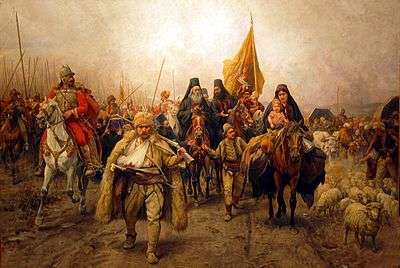
The Great Migrations of the Serbs (Serbian: Velike seobe Srba/Велике сеобе Срба), also known as the Great Exodus of the Serbs, refers mainly to two large migrations of Serbs from the Ottoman Empire to the Habsburg Monarchy.
The First Great Migration occurred during the Great Turkish War under Serbian Patriarch Arsenije III Čarnojević, and came as a result of the Habsburg retreat from Ottoman territories in the Balkans, which were temporarily held by the Habsburgs between 1689 and 1692.[1] The Second Great Migration took place in 1737–1739 under the Serbian Patriarch, Arsenije IV Jovanović, also parallel with the Habsburg withdrawal from territories that they held in the Balkans, which between 1718 and 1739 were known as the Kingdom of Serbia and Banat of Temeswar.[2] The masses of earlier migrations from the Ottoman Empire are considered ethnically Serb, while those of the First Great Migration nationally Serb. The First Great Migration brought the definitive indicator of Serbianness, Orthodox Christianity and its leader, the patriarch.[3]
Background
According to Srpsko Kulturno Društvo Prosvjeta, the influx of Serbs to the Habsburg Monarchy, constant since the fall of Serbian Despotate in the late 15th century, gained more momentum following the Statuta Valachorum act of 1630, by which the Habsburgs encouraged their settlement in the Military Krajina region.[4] Some Serbian historians, citing a document issued by Emperor Leopold I in 1690, claim that the masses were "invited" to come to Hungary. The original text in Latin shows that Serbs were actually advised to rise up against the Ottomans and "not to desert" their ancestral lands.[5]
First Migration
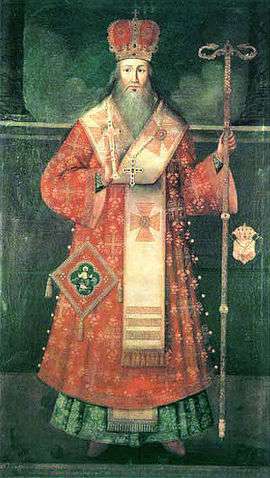
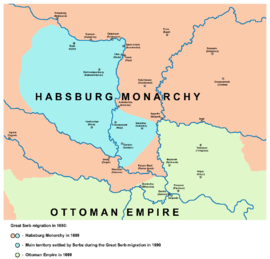
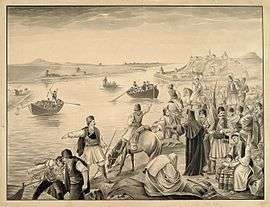
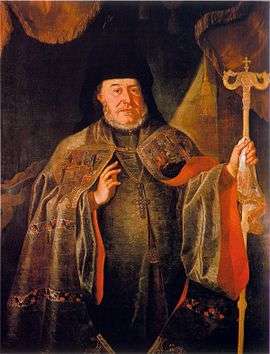
During the Austro-Turkish war (1683–1699) relations between Muslims and Christians in the European provinces of the Ottoman Empire were extremely radicalized, resulting in calls by Muslim religious leaders for the persecution of local Christians and Jews. As a result of oppression, Serbian Christians and their church leaders, headed by Serbian Patriarch Arsenije III sided with the Austrians in 1689. In the following campaigns, Turkish forces conducted systematic atrocities against the Christian population in Serbian regions, resulting in the Great Migration of 1690.
In 1690, Emperor Leopold I allowed the refugees gathered on the banks of the Sava and Danube in Belgrade to cross the rivers and settle in the Habsburg Monarchy. He recognized Patriarch Arsenije III Čarnojević as their spiritual leader.[6] The Emperor had recognized the Patriarch as deputy-voivode (civil leader of the migrants), which over time developed into the etymology of the northern Serbian province of Vojvodina[6] (this origin of the name of Vojvodina is related to the fact that patriarch Čarnojević and subsequent religious leaders of Serbs in the Habsburg Monarchy had jurisdiction over all Serbs in the Habsburg Monarchy, including Serbs of Vojvodina, and that Serbs of Vojvodina accepted the idea of a separate Serbian voivodeship in this area, which they managed to create in 1848).
In 1694, Leopold I, Holy Roman Emperor appointed Arsenije III Čarnojević as the head of the newly established Orthodox Church in the Monarchy.[7] The patriarchal right of succession was secured by the May Assembly of the Serbian people in Karlovci in 1848, following the proclamation of Serbian Vojvodina during the Serbian revolution in Habsburg lands 1848–49.[7] Serbs received privileges from the Emperor, which guaranteed them national and religious singularity, as well as a corpus of rights and freedoms in the Habsburg Monarchy.[7]
Second Migration
The fall of the Habsburg Kingdom of Serbia (1718–1739) to the Ottomans triggered the Second Serb migration into the (rest of the) Habsburg Monarchy.[7]
The Second Serb migration from 1739 was of much smaller extent than the first one from 1690 and most of the refugees from the second migration settled in Syrmia.
Number of migrants
Sources provide different data regarding the number of people in the first migration:
- 37,000 families into Habsburg Monarchy, according to a manuscript at Šišatovac monastery written by monk Stefan of Ravanica 28 years after the first wave.[8]
- 37,000 families, according to a book by Pavle Julinac, printed in 1765.[9]
- 37,000 families led by the Patriarch, according to Jovan Rajić, published in 1794–95.[10]
- 37,000 families led by the Patriarch, according to Johann Engel, published 1801.[11]
- Émile Picot concluded that it was 35,000 to 40,000 families, between 400,000 and 500,000 people. "It is a constant tradition that this population is counted by families, not by heads" also insisting that these were large extended families (see Zadruga).[12]
- The Serbian Academy of Arts and Sciences, supports the figure of 37,000 families.[7]
- Tatjana Popović, cites as many as 60,000 Serbian migrant families for the First Serbian migration alone.[13]
- At least 30,000 people, according to Stevan K. Pavlowitch.[6]
- 20,000–30,000 people, according to "Teatri europei".[14]
- According to Noel Malcolm, two statements from Arsenije survive. In 1690 he wrote "more than 30,000 souls", and six years later he wrote that it was "more than 40,000 souls".[15] Malcolm also cites Cardinal Leopold Karl von Kollonitsch's statement from 1703 of more than 60,000 people led by the Patriarch from Belgrade to the Kingdom of Hungary, a figure Malcolm claims Kollonich may have been inclined to exaggerate.[15]
According to Noel Malcolm, data that state that 37,000 families participated in this migration derive from a single source: a Serbian monastic chronicle which was written many years after the event and contains several other errors.[16]
Aftermath
Serbs from these migrations settled in parts of present-day Hungary, Vojvodina, and Croatia (they settled as far in the north as the town of Szentendre in Hungary, in which they formed the majority of population in the 18th century). To a smaller extent, they also settled in the town Komarno in Slovakia.
The large Serb migrations from Balkans to the Pannonian plain started in the 14th century and lasted until the end of the 18th century. The great migrations from 1690 and 1737–39 were the largest ones and were important reason for issuing the privileges that regulated the status of Serbs within Habsburg Monarchy. The Serbs that in these migrations settled in Vojvodina and Slavonia increased (partly) the existing Serb population in these regions and made the Serbs an important political factor in the Habsburg Monarchy over time.
See also
- Rascians, Hungarian and German name for Serbs
- New Serbia (historical province)
- Slavo-Serbia
- Serbian historiography
References
| Wikimedia Commons has media related to Great Serb Migrations. |
- ↑ Ćirković 2004, pp. 143-148.
- ↑ Ćirković 2004, pp. 154.
- ↑ Nicholas J. Miller (15 February 1998). Between Nation and State: Serbian Politics in Croatia Before the First World War. University of Pittsburgh Pre. p. 13. ISBN 978-0-8229-7722-3.
- ↑
- ↑ Sabrina P. Ramet (8 December 2005). Thinking about Yugoslavia: Scholarly Debates about the Yugoslav Breakup and the Wars in Bosnia and Kosovo. Cambridge University Press. p. 206.
- 1 2 3 Stevan K. Pavlowitch, Serbia: the history behind the name, p. 20
- 1 2 3 4 5 http://www.sanu.ac.rs/English/Arhivi/SremskiKarlovci.pdf
- ↑ Stanojevic, Ljubomir. (ed) Stari srpski zapisi i natpisi, vol 3, Beograd 1905, 94, no 5283: "37000 familija"
- ↑ Pavle Julinac, Kratkoie vredeniie v istoriiu proikhozhdeniia slaveno-serbskago naroda. Venetiis 1765 (ed. Miroslav Pantic, Belgrade, 1981), p. 156: numbers derived from an official Imperial report to Vienna.
- ↑ Jovan Rajić, Istoriia raznikh slavenskikh narodov, naipache Bolgar, Khorvatov, i Serbov, vol 4, 1795, p. 135: "37000 familii Serbskikh s Patriarkhom
- ↑ Engel, Johann Christian von, Geschichte des ungrischen Reichs und seiner Nebenländer, vol. 3. Halle 1801, 485: "37000 Serwische Familien, mit ihrem Patriarchen"
- ↑ A.E. Picot, Les Serbes de Hongrie, 1873, p. 75
- ↑ Tatjana Popović, Prince Marko: the hero of South Slavic epics, p. 28
- ↑ Aleksandar Protić, Još koja o istom, Seoba u sporovima, Novi Sad, 1991, page 91.
- 1 2 Two written statements by Arsenije survive, specifying the number of people: at the end of 1690 he gave it as "more than 30,000 souls", and six years later he wrote that it was "more than 40,000 souls". These are the most authoritative statements we have... Noel Malcolm: Albanische Geschichte: Stand und Perspektiven der Forschung; by Eva Anne Frantz. p. 238
- ↑ Noel Malcolm, Kosovo - a short history, Pan Books, London, 2002, page 161.
Sources
- Bataković, Dušan T., ed. (2005). Histoire du peuple serbe [History of the Serbian People] (in French). Lausanne: L’Age d’Homme.
- Ćorović, Vladimir (2001) [1997]. "Velika seoba Srba u Austriju". Istorija srpskog naroda. Projekat Rastko.
- Tomić, Jov. N. (1902). "Deset godina iz istorije srpskog naroda i crkve pod Turcima (1683-1693)".
- Ćirković, Sima (2004). The Serbs. Malden: Blackwell Publishing.
- Ćorović, Vladimir (2001) [1997]. "Velika seoba Srba u Austriju". Istorija srpskog naroda. Ars Libri; Rastko.
- Ivić, Aleksa (1929). Istorija srba u Vojvodini. Novi Sad: Matice srpska.
- Ivić, Aleksa (1914). Историја Срба у Угарској: од пада Смедерева до сеобе под Чарнојевићем (1459-1690). Zagreb: Привредникова.
- Pavlowitch, Stevan K. (2002). Serbia: The History behind the Name. London: Hurst & Company.
- Popović, Dušan J. (1957). Srbi u Vojvodini (1): Od najstarijih vremena do Karlovačkog mira 1699. Matica srpska.
- Tomić, Jov. N. (1902). Deset godina iz istorije srpskog naroda i crkve pod Turcima (1683-1693).
- Migrations in Balkan History. Serbian Academy of Sciences and Arts, Institute for Balkan Studies. 1989. ISBN 978-86-7179-006-2.
- Ingrao, Charles; Samardžić, Nikola; Pešalj, Jovan, eds. (2011). The Peace of Passarowitz, 1718. West Lafayette: Purdue University Press.
- Journals
- Trifunoski, Jovan (1990). "VELIKA SEOBA SRBA U NARODNIM PREDANJIMA IZ MAKEDONIJE" (PDF). Etnološke sveske. 11: 54–61.
- Gavrilović, Vladan (2016). "EXAMPLES OF SERBIAN MIGRATIONS TO HUNGARIAN PROVINCIAL DISTRICTS 1699-1737". ISTRAŽIVANJA. 25: 139–148.